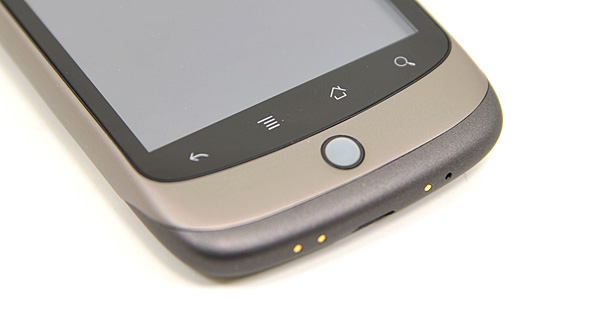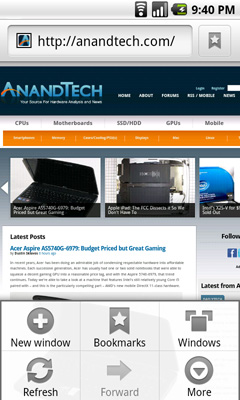Anand's Google Nexus One Review
by Anand Lal Shimpi on April 3, 2010 3:40 AM EST- Posted in
- Smartphones
- Mobile
The Home Bar
The Nexus One has three physical buttons: a power/lock button at the top, volume rocker on the left side and a trackball/button on the face.

The trackball is mostly useless. The Nexus One has a 3.7” multitouch screen for a reason, and it’s way quicker to use the screen than to use the trackpad for scrolling. There are some limited situations where the trackball can be useful, for example while playing games. The iPhone has no useful physical buttons for gaming, the Nexus One’s trackball is better for moving a character around than a virtual d-pad.
Above the trackball there are four touch buttons with fixed functions: back, menu, home and search. By default all provide haptic feedback when activated. In other words, they vibrate a bit when you touch them. It’s a fine feature but it’s nowhere near the feedback you get from physical buttons if that sort of thing matters to you. The buttons also give you the same feedback regardless of whether or not their operation is permitted in the current mode (e.g. hitting the contextual menu button when no such menu exists).
The back button is useful and works as intended, it goes back a screen. The menu button takes some getting used to. The best way I can describe it is like a right click. You get a contextual menu depending on what app you’re running. At the home screen it lets you pop into Android’s settings, add application shortcuts, change wallpaper, view notifications and search. In the email app the contextual menu lets you refresh your inbox, switch to a different folder, change settings, etc...

The contextual menu in Android's Browser app
This is where Android’s more PC-side comes out to play. Apple and Palm for the most part try to keep these sorts of menus away from you. Apps are purposefully not very deep and settings are all controlled through the settings screen, not from within an app. Functionality is driven by the UI. Android takes a more application centric approach. Neither is right or wrong, but both approaches have their pros and cons. I’d argue that Apple/Palm’s approach is better suited for something that’s going to be used as a passive device. Something you’re quickly scanning emails or text messages on. Google’s take is more PC-like. Give the users the options they want, where they want them, even at the risk of UI simplicity.
The Apple method runs the risk of limiting functionality, while Google’s risks turning the UI into a cumbersome mess. Neither is there today, but left unchecked that’s where they’d end up.
Moving on, the home button works as expected, it takes you to your home screen. The search button is particularly interesting because it is one Android feature that Microsoft copied in Windows Phone 7. Hitting the search button brings up an autocomplete enabled Google search box. Hitting go, launches the web browser (very quickly thanks to Mr. Snapdragon) and displays your search results.

What MS is proposing for WP7 are contextual search results that are formatted for the smartphone. Akin to a search app if you will. Search for GeForce GTX 480 and get a normal listing of websites. Search for dentists and get a smartphone formatted list of dentists in your area. Granted MS’ proposal is just that, a proposal, while Android is shipping today. Enabling similar functionality though shouldn’t be hard for Google. I’d love to be able to search, pull results from the web, but have the results presented as more of an app.

Windows Phone 7 Search
The search function will autocomplete things like address book entries, but it won’t automatically search your email for you. While the iPhone’s search function is more focused on searching your device, Android is more interested in helping you search the web. Google has a search engine, Apple doesn’t, the distinction makes sense.










95 Comments
View All Comments
coolVariable - Saturday, April 10, 2010 - link
Oh, STFU you fanboy.1. No calendar sync. Buggy Contact sync (e.g. contact pics, birthdays, ...). Buggy e-mail sync (just stops randomly). STFU since you have no clue what you are talking about.
3. A phone that can't even make calls. GREAT!!!! I don't fvcking care what the reason for the problem is. A $600 phone should be able to make a fvcking phone call!!!!!!
4. Love your little walled garden? Why don't you get an Apple phone if you are soooooo in love with a company locking down the functionality of your phone???????? Anand bad-mouthes Apple for its walled garden and ignores this "walled garden"???
5. Walled garden! Walled garden! Walled garden! Walled garden!
All of the above are pretty big problems with android per se and the Nexus One specifically!
It's pathetic that they weren't even mentioned during this review.
Not to mention the myriad of other (often cosmetic) problems and bugs with android (e.g. contact sort, etc).
And a tech-savy reviewer would have also mentioned the hypocrisy that you need to "jailbreak" android to do a lot of things. While that is fine, it pretty hypocritical that you can't "un-jailbreak" the Nexus One for a warranty exchange (something that is pretty easy to do with the iphone).
ruzveh - Sunday, April 11, 2010 - link
Anand nice article and m also looking fwd to buy one phone in near future from GoogleFrom my point of view is that 1GHz processor with 65nm is draining the battery life. Imagine if u insert 1GHz processor with 32nm (todays std) or even less will boost ur battery life almost double. I dont understand so called this chip company why not jumping onto 32nm bandwagon or to somewhat 25nm or even less?
i just feel these cos r wasting so called resources and time for money / profits. Dont they knw resources r limited and so purchasing power.
Thats secondary thing. Ohh what? r u thing i forgot to mention primary issue? lolz
Well its obvious.. Innovation in Battery power. What i hate in mobiles are speed and battery life for which i m ending up using my cell ph for only calls & ofcourse sms since past 8yrs 6630 and not willing to change untill they come up with good phones..
coming back to battery life i really dont understand why these cos r not doing something in batter life when there is lot of room for improvement in it like todays model feature only 1500mah battery power wheres a small pencil cell can go all the upto 3000mah or even more. We definitely want to see double the capacity then what they r featuring today.. Anand can u clear me on this prospect?
I am v much sure if v give proper attention in this area we can do wonders. Comon someone has to do something sooner or the later...
7.saturnine - Wednesday, April 14, 2010 - link
I don't understand the trend of putting as few physical buttons on a device as possible. How do you skip or pause music when the device is in your pocket? Pull it out, unlock the screen, find the music app & press the button? That is ridiculous.On my HTC Touch (WinMo6) it has hardly any buttons either, but at least one programmable physical button (that I have programmed to open the camera from any app I am in) & a directional pad/enter button. Sometimes I just like using the directional pad to go through menus & select something rather than moving my thumb all the way up the screen. Yes that sounds incredibly lazy, but aren't these devices all about ease of use, simplicity & speed? Programmable hardware buttons do just that. They are focusing too much on the aspect of a touch screen.
Affectionate-Bed-980 - Thursday, April 15, 2010 - link
This seems to be a forgotten thing. I spent 2 hrs playing around writing probably pages worth of notes just to test it out on Android.You say the iPhone lackED it? I have an iPod Touch 1G and I guess I'm used to multitouch by now, but how long did it take for Apple to add it? I notice how ridiculously fast I can type on it and not skip words/keys. On Android, it's a totally different thing.
A few tips from me as I've investigated this for a long time and I've made cries out on Android forums with very little sympathy:
1) HTC's IME keyboard that is modded on XDA is a LOT better. The developer tried to implement a little pseudo multitouch so it is more used to you pressing the next key before releasing the previous. This is a HUGE issue with the space bar and if you use the stock android keyboard, you're going to be skipping words like mad if you type too fast.
2) Smart Keyboard Pro has multitouch. It also features a debug mode that you can look at your touch points. It definitely picks up multitouch flawlessly. Is it as good as the iPhone keyboard? Somehow I was still typing faster on my iPod than on my Android phone with Smart Keyboard Pro.
However, with the mods the modders have made on the HTC IME Keyboard, I've decided to stick with it. It's getting better and it's handling multitouch somewhat even though it's not a true multitouch implementation.
But you're right. It's night and day without multitouch. For people who haven't used the iPhone enough, they fail to appreciate the keyboard. Most people just go "Oh I type fine on my Nexus One. I type pretty fast." Obviously you can't type THAT fast if it lacks multitouch. Maybe they should look at what "fast" means on the iPhone :D
rossmandor - Monday, August 30, 2021 - link
nice one